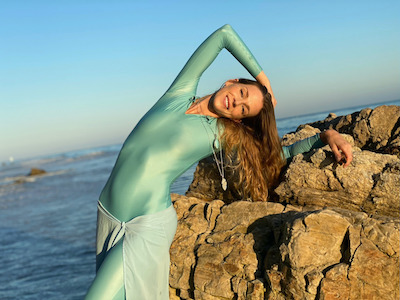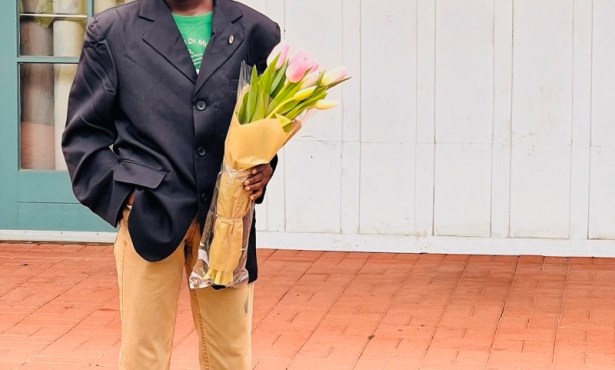Amanda Gregory, Consciousness Explorer
Classically Trained Singer Collaborates with Neuroscientists to Create Interactive Performances
By Melody Pezeshkian

A bald, blue-eyed singer maneuvers through the crowd. Communicating without words, she beckons the rapt audience into a transliminal communion. Pointing to the distance, she invites the audience to interpret what visuals may correspond to the sounds of her voice.
She then dons a white wig and steps on stage into a 12-foot-tall white dress created by artist Patrick Renner, metamorphosing into an ornately festooned entity. The imagery comes alive; patterns coalesce behind her, and her wig changes color in synchrony with her voice thanks to tech and video art by Bradley Muñoz and Jonathan Jindra. Finally, the audience can drop their speculations and become fully immersed in her world.
“I was portraying an entity from another dimension,” says digital opera artist Amanda Gregory by way of explaining Xenoglossia, the performance described above. Presented at the Contemporary Arts Museum in Houston in 2015, this collaboration with musician Zárate Zaaló represents just one of the many unorthodox approaches that Gregory uses to engage audiences and foster a playful atmosphere during her shows. With her distinctive blend of digital visuals and psychoacoustic audio, Gregory is a regular at events such as Burning Man, Lightning in a Bottle, the NeuroLeadership Summit, and the Google I/O Conference. Although this puts her firmly in league with the cutting edge of performance art, her fascination with contemporary music and psychoacoustic experimentation has not stopped her from also following her inclination toward classical music, which she has performed in more conventional venues in Germany and Italy.
Born in Houston, Texas, Gregory now considers Santa Barbara her home. She teams with other creators and scientists at the Santa Barbara Center for Art, Science, and Technology (SBCAST) and at UCSB’s META Lab to create sound experiences that aim to explore beyond the known boundaries of the mind. One of Gregory’s regular collaborators is Alan Macy, a biomedical engineer and founder of BIOPAC Systems, a company that develops medical software in Santa Barbara. Macy describes what he terms a brilliant collaboration with Gregory this way: “We have ongoing discussions about pattern, resonance, coherence, physiological cycles, haptics, and music.” All of her musical performances are scientifically informed, drawing inspiration from neuroscience, music theory, and psychology.
Creative Lineage

Gregory began singing at the age of 7 after discovering that she was adopted. “All of a sudden, I imagined that I could come from this family of singers,” she says of how she began to assemble a personal creative lineage. After her early vocal coaches commended her for natural vibrato, Gregory began classical voice training for opera. As a result, her sound has since evolved into a vibrant and richly executed operatic voice. Although she briefly considered the fields of marine biology and forensic pathology, she wound up matriculating at Manhattan School of Music in New York City. Still her curiosity led her to continue exploring the question of “what we are as humans,” which ultimately influenced her unique creative path. Being an artist, she says, is her “way of taking a microscope to the human experience.” As a graduate student, her coursework focused on the world of contemporary classical music and modern opera — a genre that “is often very informed by mathematics.” Through her education, she “started to be curious about the vibrational element of music,” in particular the fact that “everything has a pitch … every sound has a pitch that it makes.”
Contemporary music drew her in because she felt that “what’s been done before was somehow too traditional.” This interest, combined with her classical training, led her to join the Nouveau Classical Project, a multimedia performance group that appealed to younger audiences. This creative alliance marked a shift from standard contemporary classical performance to a more multidisciplinary approach. As a multifaceted creator, she embraced the shift. “I realized after my master’s program, that there was a place for these more unusual combinations of media.”
In 2013, she joined the Knells, an award-winning art rock ensemble. She appreciated the way that the Knells “explored the mathematics of Pythagoras and Escher” in their songs. Through this experience, her own work became more kaleidoscopic and experimental. This was when she began skillfully combining classical music, digital art, movement, and science in her immersive performances.
New Ways of Seeing
Today, Gregory finds herself at the forefront of a movement to engage sound dynamics and the scientific study of consciousness within the world of performance art. Her artistic knowledge and musical expertise add a much-needed dynamic perspective to both realms. Traversing the roles of singer, artist, and scientist, Gregory adds invaluable depth and understanding to each. The intersection of science and music is a nascent domain budding with innovation; Gregory finds herself an intermediary between two realms, fluent in the languages of tech and music.

When I met with Gregory in June, she dropped a large binder on her desk — filled entirely with her recent creative projects and ideas. When I asked what her latest endeavor was, she described a performance she’s giving at the Diverse Intelligences Summer Institute that will explore intelligence and cognition in humans and in plants. If there’s one thing that ties her expansive body of work together, it’s precisely what diversifies it in this way — her seemingly endless exploration.
Gregory explains this as a commitment to “finding new ways of seeing.” “Any way that I can feel and experience life in a new way helps to open new doors,” she said. Brimming with potential for unexpected discoveries, her interactive performances are more unifying than one might expect. Asked what draws her to these performances where she and the audience interact, Gregory said that it’s the way that “by the end, we come to this place of unconditional love and a sense of freedom.” Despite her frequently extraterrestrial and futuristic subject matter, Gregory nevertheless summons an intuitive, profound sense of togetherness and harmony within the room.
The audiences for her performances leave having gained a unique shared experience on top of witnessing a stellar musical performance. Her productions explore unfamiliar realms, compelling listeners to question their internal states and potentially move past mental blocks into new spaces of consciousness. Summing all this up can be difficult, but for Gregory, there is an answer. She told me that if she “could only say one thing that they [her audience] could have or be or feel or experience, it would be love.”
A Voice Out of Nature
Gregory attributes the “wonder and awe” in her work to her deep connection to nature as a source of “themes to explore in musical experiences.” At the Verge-18 energy conference in 2018, she used a machine to “loop [her] voice to make it look like [it] was coming from nature.” The conference, as described on her website, “brings together a diverse audience to explore the opportunities and challenges in decarbonizing global energy systems” Gregory is also a member of a unique collaborative, the Design Science Studio for global creators, organizations, and initiatives to work together to imagine, collaborate, and create a regenerative future by championing sustainability.

In April 2019, she started working at the Spatial Sound Institute in Budapest on a project called Atlas of Emotions, which began as a visual online tool commissioned by the Dalai Lama and evolved into an “immersive sound project in partnership with the Greater Good Science Center at UC Berkeley, MONOM, and Google AI.” She describes the project as an “embodied understanding of our emotional experiences,” where the team “mapped the sound of waves to sweep across the room with my arms. I could lift my hands to the sky as the sound of waves morphed into the sound of rain; pounding my fists would create the sound of thunder; opening my palms would fill the room with the sound of birds.” This level of high-tech synesthesia aims to explore the “ever-evolving flux of human feeling.”
It was through Atlas of Emotions that she met Dr. Mike North, a researcher at the Santa Barbara Center for Arts Science and Technology (SBCAST), and this inspired her to move here. For Gregory, Santa Barbara offers an ideal location to make connections between scientific research, nature, and art. Her journey as a musician has been filled with synchronicities. This journey, she says, has “inspired me to consider the possibility of love underneath this all somewhere, somehow.”
With Dr. North, she began collaborating with the I/O Lab at SBCAST, which she described as being “quite like a dream” for her, “to finally be able to do real research on the fundamentals of sound, vibration, and frequency.” Her journey has led her to also currently collaborate with her fiancé and UCSB professor Dr. Jonathan Schooler at the UCSB’s META Lab, producing Meta Music. “Meta Music includes a series of audio-visual compositions designed to translate scientific discoveries and theories of consciousness, offering benefits such as increased openness to experience and mindfulness.” When performing Meta Music, Gregory improvises live to create psychoacoustic effects that may induce meditative experiences for listeners. Gregory envisions that Meta Music may eventually be used in interactive art gallery installations and even in therapy.
Gregory concurrently hosts immersive online performances that are thus available to a broader audience. While her in-person performances are truly unique, much of the captivating and immersive aspects of her performances translate virtually, especially with headphones.
As collective experience is a hallmark of her performances, Gregory champions the current return to in-person work. When we last spoke, Gregory had just hosted a Silent Disco at Leadbetter Beach for her birthday, intimating that a more public Silent Disco is forthcoming.
To learn more, and potentially participate in that Silent Disco, visit amandagregory.com, where she posts samples of her performances and lists upcoming events.




You must be logged in to post a comment.